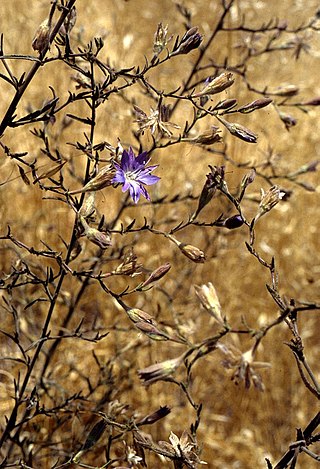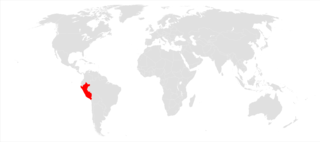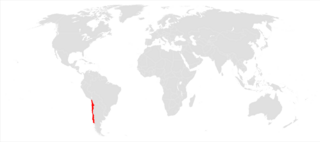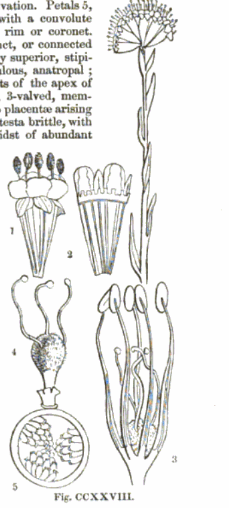
The Atacama Region is one of Chile's 16 first order administrative divisions. It comprises three provinces: Chañaral, Copiapó and Huasco. It is bordered to the north by Antofagasta, to the south by Coquimbo, to east with Provinces of Catamarca, La Rioja and San Juan of Argentina, and to the west by the Pacific Ocean. The regional capital Copiapó is located at 806 km (501 mi) north of the country's capital of Santiago. The region occupies the southern portion of the Atacama Desert, the rest of the desert is mainly distributed among the other regions of Norte Grande.

Malesherbia is a genus of flowering plants consisting of 25 species in the Passifloraceae. This is a xerophytic group endemic to the Peruvian and Chilean deserts and adjacent Argentina. The genus is currently recognized by the APG III system of classification in the family Passifloraceae, and is the sole member of the subfamily Malesherbioideae.

Prosopis tamarugo, commonly known as the tamarugo, is a species of flowering tree in the pea family, Fabaceae, subfamilia Mimosoideae. It is only found in northern Chile, particularly in the Pampa del Tamarugal, some 70 km (43 mi) east of the city of Iquique. This bushy tree apparently grows without the benefit of rainfall, and it is thought to obtain some water from dew. Studies indicate it is a Phreatophyte; having deep roots that tap into ground water supplies. It also participates in hydraulic redistribution moving water from deeper levels to the upper and also reversing the process in times of severe drought.

Since the mid-1990s, tourism in Chile has become one of the main sources of income for the country, especially in its most extreme areas. In 2005, this sector grew by 13.6%, generating more than US$500 million, equivalent to 1.33% of the national GDP.

Stemodia durantifolia is a species of flowering plant in the plantain family commonly known as the whitewoolly twintip and purple stemodia. Stemodia durantifolia is native to the Americas, including Chile, Mexico, Texas, and the deserts of California and Arizona, and is often found in riparian habitats, preferring wet sand and rocks. It is a perennial herb producing a hairy, glandular, erect stem 10–100 cm (3.9–39.4 in) tall, with the toothed lance-shaped leaves found in pairs or triplets, attached to the stem with clasping bases. The inflorescence is a raceme of violet flowers, with each corolla held in a calyx of hairy, pointed sepals, and can often be found in bloom year-round. Although globally at low risk of extinction, Stemodia durantifolia is imperiled in California due to its rarity and threats from development.

A desert bloom is a climatic phenomenon that occurs in various deserts around the world. The phenomenon consists of the blossoming of a wide variety of flowers during early-mid spring in years when rainfall is unusually high.

Malesherbia angustisecta is an endangered member of Malesherbia (Passifloraceae). It is colloquially called clavelina. The first published description of the species dates to 1922 and Hermann Harms is accredited with its discovery. It is native to arid and semiarid deserts of Peru. It is a pale green woody shrub and has pale pink / white flowers.

Malesherbia ardens, a member of Malesherbia (Passifloraceae), is a shrub with red flowers, native to the arid deserts of Southern Peru, though it can be found in the northern regions of the country. It is colloquially called Lampaya. The oldest known record of M. ardens dates 1927 in the 4th volume of the Field Columbian Museums' Botanical series. James Francis Macbride is accredited with its discovery.

Malesherbia auristipulata is a perennial woody shrub in the genus Malesherbia (Passifloraceae). Locally it is called Ají de Zorra. M. auristipulata is commonly found in Northern Chili and rarely in Tacna, Peru. In general, the species range is very restricted as a result M. auristipulata is considered a rare plant. It is likely that there are less than 100 individuals left, classifying the species as critically endangered by the local government.

Malesherbia bracteata is a perennial herb in Malesherbia (Passifloraceae). M. bracteata var. bracteata found in the deserts of the Andes and Coquimbo, while M. bracteata var. campanulata is only found around Embalse La Laguna. Malesherbia bracteata can grow up to 18mm and has white flowers. Variety campanulata differs from variety bracteata in terms of leaf shape, floral cup, and stipules.

Malesherbia corallina, a member of Malesherbia (Passifloraceae), is a subshrub native to the deserts and dry shrubland of Tarapacá Chile. It was originally identified in 2003 by Mélica Muñoz-Schick and Pinto, and is considered very rare with less than 20 plants documented.

Malesherbia densiflora is a perennial herb native to the Andean foothills in Atacama Chile. M. densiflora can grow up to 40 cm tall and has white racemose flowers.

Malesherbia deserticola is a subshrub native to the deserts and dry shrublands of Antofagasta and Atacama Chile. It can reach heights of 40 cm and has white racemose flowers.

Malesherbia fasciculata is a subshrub that is native to the subtropics of Northern and Central Chile. The flowers of M. fasciculata are white with red sepals, dark purple anthers, and are globular in shape.

Malesherbia humilis is an annual herb that grows in the subtropics of northern and central Chile to Argentina.

Malesherbia linearifolia is a subshrub native to the Coquimbo, Valparaiso, Metropolitana, and O'Higgins regions of Chile. It was the first member of Malesherbia to be described, with the original description dating to 1797 by Cavanilles.
Malesherbia lirana is a perennial herb whose native range is from Argentina and Chile. The species has racemose inflorescences that are 2 - 3.9 cm in size and cream colored petals. It flowers in spring to late summer.

Malesherbia paniculata is perennial subshrub native to the Atacama, Coquimbo, Valparaíso, Metropolitana, and O'Higgins regions of Chile. It can be found at elevations of up to 2600m to sea level. It was originally described in 1827 by D. Don.
Malesherbia solanoides is a subshrub native to the Atacama region of Chile. It was initially described in 1833 by Reise Erde.
Malesherbia weberbaueri is a subshrub native to Apurímac, Ayacucho, Huancavelica and Junín. It is found at altitudes of 2300-3600 meters.













